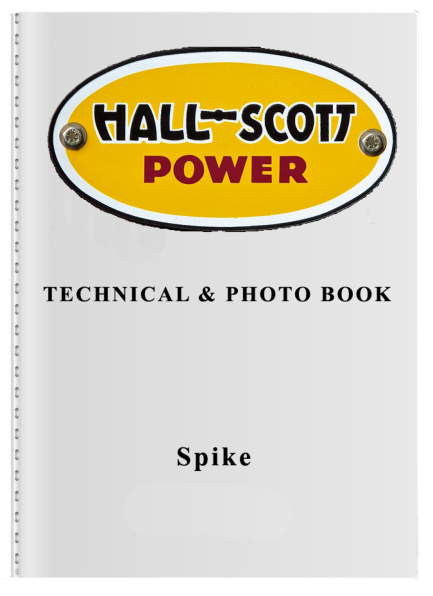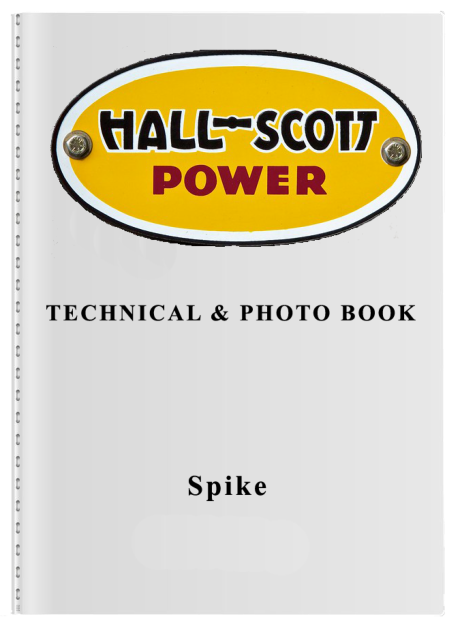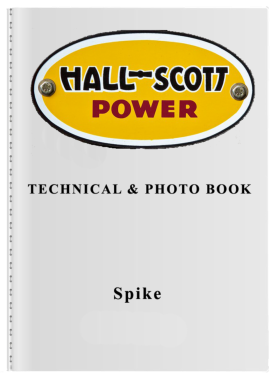


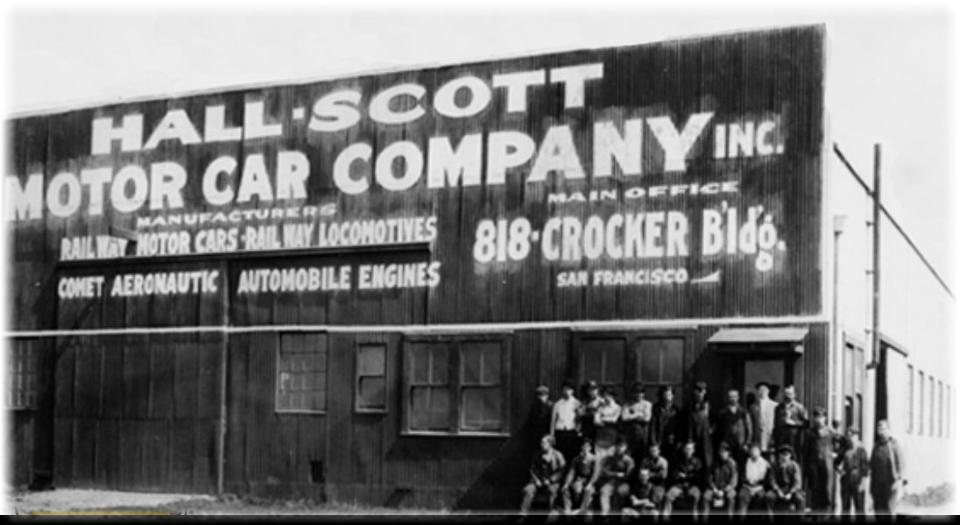
Some Hall-Scott History
1907
It
starts
with
Hall's
Auto
Repair,
repairing
engines
and
cars
and
building
his
Comet
cars
with
a
4
Cyl.
4x4,
201
cubic
inch,
25
HP
engine.
Hall
toyed
with
his
engine
using
an
in-line
6
cyl.
and
later
a
V-8
engine for the Comet.
1908
Bert
Scott
meets
Hall
at
his
shop
to
get
his
automobile
looked
over,
after
a
short
conversation
Scott
took
Hall
for
a
ride
on
one
of
the
underpowered
railcars
of
the
Yreka
Railway.
They
decided
that
together
they
could
build
a
stronger
better
performing
engine.
A
partnership
is
formed
and
the
start
of
the
Hall-Scott
Motor
Car
Co.
The
first
engines
were
8"
bore
x
10"
stroke
and
Hall
made
variations
of
4 cyl. @2010 c.i., 6 cyl. @ 3014 c.i. and 8 cyl. @ 4019 c.i. in-line engines.
1910
Airplane
engines
production
started
with
4
cyl.
A-1
in-line
4x5,
32
HP.
Engine
production
continued
with
the
"V"
type
engines,
A-2,
A-3
and
the
A-4
varying
from
4x4
to
4x5
to
5x5
bore
&
stroke,
ranging
from
60
H.P.
to
100
H.P.
The
A-2
"V"
type
sold
for
$2000.
in
1911.
A-5
&
A-5a
came
later
with
5x7,
as
did
the
A-7
&
A-7a
with
909.2
c.i.
@
150-165
H.P.
The
V-12.
A-8,
came
about
in
1911,
5"
bore
x
7"
stroke,
1649.3
c.i.
@
300
H.P.
Engine
production
continued
and
in
1917
Mr.
Hall
and
Vincent
from
Packard
Motors
designed
the
Liberty
engine
for
the
war
effort
at
421
H.P.
it
was
one
of
the
most
powerful
airplane
engines
of
the
day.
Hall-Scott
and
Henry
Ford.
Ford
had
Hall
design
a
engine
for
the
Model
T,
Hall
called
it
the
little
"T",
in-line
6
with
the
valves
on
the
side,
but
Ford
didn’t
want
to
add
length
to
the
car
and
went
with
the
v-8.
Hall
also
designed
and
built
2
other
engines
for
Ford;
one
was
a
horizontal
5x7
4
cyl.
@
75
H.P.
underfloor
for
Ford
rail
cars,
the
other
was
a
8
cyl.
@150
H.P.
(this
sparks
Hall
to
think
about
horizontal
engines
for
other
applications.)
Hall's
relationship
with
Harry
Miller
came
about
with
Miller
supplying
Hall-Scott
with
carbs
for
the
airplane
&
early
marine
engines,
Hall
helped
Miller
with
certain
engine
designs
like
camshaft
lobes,
Hall's
reputation
was
well
known
in
the
racing
world
with
his
designs
of
chamber
shape,
cams,
valves
and
Hall's
combustion
chamber
with
his
"hemi"
design.
Hall-Scott's
relationship
with
International
Harvester
started
and
ended
with
HS
designing
Models
151,
41/4"x
51/2"
@312
c.i.
&
152,
43/4"
x
51/2"
@
390
c.i.
and
producing
over
6000
engines
for
I.H.
mid-sized
trucks.
This
ended
in
1931
and
HS
re-branded
these
engines
models
165
&
167 for truck, marine, bus and industrial. One became the 4 cyl. Fisher Jr. (178-2 model)
marine using the 41/4" x 51/2" size.
1925
Hall
and
Scott
sold
the
engine
company
to
American
Car
&
Foundry,
Hall
continued
to
work
at
HS
as
General
Manager,
Scott
continued
as
President,
and
both
were
gone
by
1938.
By
1925
HS
dropped
all
production
of
airplane
engines,
had
nothing
more
to
do
with
the
Liberty,
and
had
dropped
many
models
including
the
95's,
100's,
140's,
150's
and
some
of
the
160's
from
production,
and
had
rebranded
any
low
sales
engines
to
other
models,
using
the
same
"core"
in
many
of
its
re-branded
models.
1936
Invader
marine
models
168
&169,
and
models
173,
175,
175-1,
177
all
became
truck,
bus,
industrial
production
engines
all
through
the
second
world
war
up
to
the
engine
division
sell
off.
The
400
series,
which
included
the
855
c.i.,
935
c.i.
and
1091
c.i.
became
some
of
the
company’s
best-selling
engines
used
in
trucks,
military,
industrial
applications.
The
model
440
became
the
engine
used
in
the
M-26
tank
retriever
during
the
second
world
war.
The
V-12
a
massive
5000-pound,
turbo
and
supercharged
engine
was
used
in
many
different
sized
boats
and
ships
not
only
in
America's
Navy
but
in
several
other
countries
navies
during
the
war
and
was
used
as
a
stationary
and
industrial
engine
well
after
the
war.
Defender
models
1268
&
1269
engines
became
models
2268
&
2269
marine
engines,
the
models
3368
&
3369
were
the
supercharged
marine
engines.
The
horizontal
engines
were
models
130,
136,
455,
475,
485,
495,
504,
590,
160
&
779
were
used
mainly
for
bus
application,
one
504
model
was
used
in
a
LA
Fire
Dept
equipment
truck.
In
all
Hall-Scott
designed
and
produced
32
different
models
and
over
50
variations
of
different
size
engines
for
many
applications
including
railcar,
airplane,
marine,
bus,
truck,
landing
craft,
boats,
and
ships,
and
stationary
or
industrial.
Mr.
Hall
had
his
signature
on
every
single
one,
even
33
years
after
he
was
gone.
He
was
a
prolific
engine
designer
and
builder,
wanting
only
the
best
materials
and
components
in
the
engines
he
deemed
ready
for
production.
There
is
so
much
more
information
on
Mr.
Hall
and
Mr.
Scott
and
the
detailed
history
of
Hall-Scott
and
the
companies
that
owned
and
ran
the
engine
division
in
Ric's
book
and
anyone
who
enjoys engines and history and a timeline of America will enjoy the read very much.
Thank you,
Spike

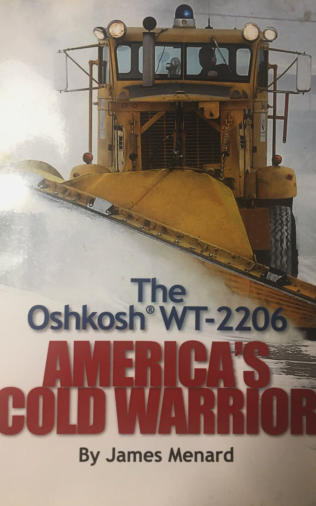
James Menard
This book covers the history of the Oshkosh WT-2206 snow removal vehicle used by the U.S. Air Force from the late 50's thru the late 70's, which first used the Hall-Scott engines in the prototype and first 10 years of service. It was an important vehicle needed to keep the runways open during the cold war. It’s history and photographic evidence were shrouded by the security protocols of the nuke bases they were deployed at. The trucks history from inception, development, rebuilds, variants, attachments and components are all explained with rich color photos and diagraming. The Hall-Scott 1091 engine and Caterpiller engines are all taken apart and described. Each with their own chapters, as well as all other mechanical, hydraulics, drive train, brakes and auxiliary components. It is 367 pages of information and expensive, but worth every penny. To purchase this book, email us at jmenard1@charter.net
HALL-SCOTT ENGINES
CONTACT SPIKE
817-760-6229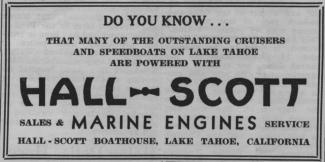
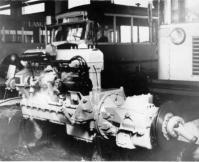
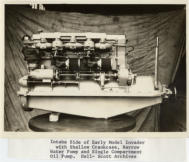
®


“Attention”
Don’t scrap that engine or parts. Call us instead,
we will help you find a home for them.

Hall-Scott
Engine Company


1907
It
starts
with
Hall's
Auto
Repair,
repairing
engines
and
cars
and
building
his
Comet
cars
with
a
4
Cyl.
4x4,
201
cubic
inch,
25
HP
engine.
Hall
toyed
with
his
engine
using
an
in-line
6
cyl.
and
later
a
V-8
engine for the Comet.
1908
Bert
Scott
meets
Hall
at
his
shop
to
get
his
automobile
looked
over,
after
a
short
conversation
Scott
took
Hall
for
a
ride
on
one
of
the
underpowered
railcars
of
the
Yreka
Railway.
They
decided
that
together
they
could
build
a
stronger
better
performing
engine.
A
partnership
is
formed
and
the
start
of
the
Hall-Scott
Motor
Car
Co.
The
first
engines
were
8"
bore
x
10"
stroke
and
Hall
made
variations
of
4
cyl.
@2010
c.i.,
6
cyl.
@
3014
c.i.
and
8
cyl.
@
4019
c.i.
in-line
engines.
1910
Airplane
engines
production
started
with
4
cyl.
A-
1
in-line
4x5,
32
HP.
Engine
production
continued
with
the
"V"
type
engines,
A-2,
A-3
and
the
A-4
varying
from
4x4
to
4x5
to
5x5
bore
&
stroke,
ranging
from
60
H.P.
to
100
H.P.
The
A-2
"V"
type
sold
for
$2000.
in
1911.
A-5
&
A-5a
came
later
with
5x7,
as
did
the
A-7
&
A-7a
with
909.2
c.i.
@
150-165
H.P.
The
V-12.
A-8,
came
about
in
1911,
5"
bore
x
7"
stroke,
1649.3
c.i.
@
300
H.P.
Engine
production
continued
and
in
1917
Mr.
Hall
and
Vincent
from
Packard
Motors
designed
the
Liberty
engine
for
the
war
effort
at
421
H.P.
it
was
one
of
the
most
powerful
airplane
engines
of
the
day.
Hall-Scott
and
Henry
Ford.
Ford
had
Hall
design
a
engine
for
the
Model
T,
Hall
called
it
the
little
"T",
in-line
6
with
the
valves
on
the
side,
but
Ford
didn’t
want
to
add
length
to
the
car
and
went
with
the
v-8.
Hall
also
designed
and
built
2
other
engines
for
Ford;
one
was
a
horizontal
5x7
4
cyl.
@
75
H.P.
underfloor
for
Ford
rail
cars,
the
other
was
a
8
cyl.
@150
H.P.
(this
sparks
Hall
to
think
about
horizontal
engines
for
other
applications.)
Hall's
relationship
with
Harry
Miller
came
about
with
Miller
supplying
Hall-Scott
with
carbs
for
the
airplane
&
early
marine
engines,
Hall
helped
Miller
with
certain
engine
designs
like
camshaft
lobes,
Hall's
reputation
was
well
known
in
the
racing
world
with
his
designs
of
chamber
shape,
cams,
valves
and
Hall's
combustion
chamber
with
his
"hemi"
design.
Hall-Scott's
relationship
with
International
Harvester
started
and
ended
with
HS
designing
Models
151,
41/4"x
51/2"
@312
c.i.
&
152,
43/4"
x
51/2"
@
390
c.i.
and
producing
over
6000
engines
for
I.H.
mid-sized
trucks.
This
ended
in
1931
and
HS
re-branded
these
engines
models
165
&
167
for
truck,
marine,
bus
and
industrial.
One
became
the
4
cyl.
Fisher Jr. (178-2 model) marine using the
41/4" x 51/2" size.
1925
Hall
and
Scott
sold
the
engine
company
to
American
Car
&
Foundry,
Hall
continued
to
work
at
HS
as
General
Manager,
Scott
continued
as
President,
and
both
were
gone
by
1938.
By
1925
HS
dropped
all
production
of
airplane
engines,
had
nothing
more
to
do
with
the
Liberty,
and
had
dropped
many
models
including
the
95's,
100's,
140's,
150's
and
some
of
the
160's
from
production,
and
had
rebranded
any
low
sales
engines
to
other
models,
using
the
same
"core"
in
many of its re-branded models.
1936
Invader
marine
models
168
&169,
and
models
173,
175,
175-1,
177
all
became
truck,
bus,
industrial
production
engines
all
through
the
second
world
war
up
to
the
engine
division
sell
off.
The
400
series,
which
included
the
855
c.i.,
935
c.i.
and
1091
c.i.
became
some
of
the
company’s
best-selling
engines
used
in
trucks,
military,
industrial
applications.
The
model
440
became
the
engine
used
in
the
M-26
tank
retriever
during
the
second
world
war.
The
V-12
a
massive
5000-pound,
turbo
and
supercharged
engine
was
used
in
many
different
sized
boats
and
ships
not
only
in
America's
Navy
but
in
several
other
countries
navies
during
the
war
and
was
used
as
a
stationary
and
industrial
engine
well
after
the
war.
Defender
models
1268
&
1269
engines
became
models
2268
&
2269
marine
engines,
the
models
3368
&
3369
were
the
supercharged
marine
engines.
The
horizontal
engines
were
models
130,
136,
455,
475,
485,
495,
504,
590,
160
&
779
were
used
mainly
for
bus
application,
one
504
model
was
used
in
a
LA
Fire
Dept
equipment
truck.
In
all
Hall-Scott
designed
and
produced
32
different
models
and
over
50
variations
of
different
size
engines
for
many
applications
including
railcar,
airplane,
marine,
bus,
truck,
landing
craft,
boats,
and
ships,
and
stationary
or
industrial.
Mr.
Hall
had
his
signature
on
every
single
one,
even
33
years
after
he
was
gone.
He
was
a
prolific
engine
designer
and
builder,
wanting
only
the
best
materials
and
components
in
the
engines
he
deemed
ready
for
production.
There
is
so
much
more
information
on
Mr.
Hall
and
Mr.
Scott
and
the
detailed
history
of
Hall-Scott
and
the
companies
that
owned
and
ran
the
engine
division
in
Ric's
book
and
anyone
who
enjoys
engines
and
history
and
a
timeline
of
America will enjoy the read very much.
Thank you,
Spike
Some Hall-Scott History

TECHNICAL & PHOTO MEMORY STICK BOOK
Compiled from thousands of update sheets,
Hall-Scott
build
and
engine
lists,
with
components
and
carb
information
going
back
to
1926.
This
book
includes
articles,
never
seen
before
Hall-Scott
ads
and
company
photos.
Over
a
thousand
pages
of
engine
builds
with
components
and
over
eleven
thousand
Hall-Scott
engine
serial
numbers
listed
all
conveniently condensed on to a memory stick.
To
purchase
this
“Memory
Stick
Book”
,
send
a
check
or
money
order
for
$35.00,
which
includes
mailing cost to a U.S. address, payable to
Spike, 4524 Foster Street, Little Rock, AR 72204.
Make
payable
to
Spike.Be
sure
to
include
your
return
address.
Thanks, Spike
To purchase this book, email us at
spike1956@sbcglobal.net
James Menard
This book covers the history of the Oshkosh WT- 2206 snow removal vehicle used by the U.S. Air Force from the late 50's thru the late 70's, which first used the Hall-Scott engines in the prototype and first 10 years of service. It was an important vehicle needed to keep the runways open during the cold war. It’s history and photographic evidence were shrouded by the security protocols of the nuke bases they were deployed at. The trucks history from inception, development, rebuilds, variants, attachments and components are all explained with rich color photos and diagraming. The Hall-Scott 1091 engine and Caterpiller engines are all taken apart and described. Each with their own chapters, as well as all other mechanical, hydraulics, drive train, brakes and auxiliary components. It is 367 pages of information and expensive, but worth every penny. To purchase this book, email us at jmenard1@charter.net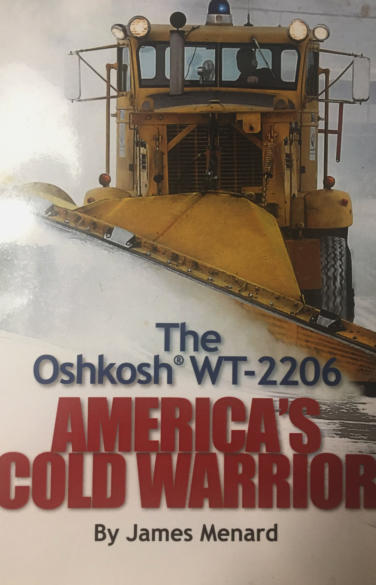
HALL-SCOTT ENGINES
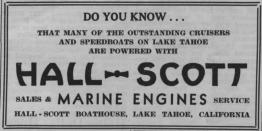

®

“Attention”
Don’t scrap that engine or parts.
Call us instead, we will help you find a home for
them.
Hall-Scott
Engine Company


®

1907
It
starts
with
Hall's
Auto
Repair,
repairing
engines
and
cars
and
building
his
Comet
cars
with
a
4
Cyl.
4x4,
201
cubic
inch,
25
HP
engine.
Hall
toyed
with
his engine using an in-line 6 cyl. and later a V-8 engine for the Comet.
1908
Bert
Scott
meets
Hall
at
his
shop
to
get
his
automobile
looked
over,
after
a
short
conversation
Scott
took
Hall
for
a
ride
on
one
of
the
underpowered
railcars
of
the
Yreka
Railway.
They
decided
that
together
they
could
build
a
stronger
better
performing
engine.
A
partnership
is
formed
and
the
start
of
the
Hall-Scott
Motor
Car
Co.
The
first
engines
were
8"
bore
x
10"
stroke
and Hall made variations of 4 cyl. @2010 c.i., 6 cyl. @ 3014 c.i. and 8 cyl.
@ 4019 c.i. in-line engines.
1910
Airplane
engines
production
started
with
4
cyl.
A-1
in-line
4x5,
32
HP.
Engine
production
continued
with
the
"V"
type
engines,
A-2,
A-3
and
the
A-
4
varying
from
4x4
to
4x5
to
5x5
bore
&
stroke,
ranging
from
60
H.P.
to
100
H.P.
The
A-2
"V"
type
sold
for
$2000.
in
1911.
A-5
&
A-5a
came
later
with
5x7,
as
did
the
A-7
&
A-7a
with
909.2
c.i.
@
150-165
H.P.
The
V-12.
A-8,
came
about
in
1911,
5"
bore
x
7"
stroke,
1649.3
c.i.
@
300
H.P.
Engine
production
continued
and
in
1917
Mr.
Hall
and
Vincent
from
Packard
Motors
designed
the
Liberty
engine
for
the
war
effort
at
421
H.P.
it
was
one
of
the
most
powerful
airplane
engines
of
the
day.
Hall-Scott
and
Henry
Ford.
Ford
had
Hall
design
a
engine
for
the
Model
T,
Hall
called
it
the
little
"T",
in-line
6
with
the
valves
on
the
side,
but
Ford
didn’t
want
to
add
length
to
the
car
and
went
with
the
v-8.
Hall
also
designed
and
built
2
other
engines
for
Ford;
one
was
a
horizontal
5x7
4
cyl.
@
75
H.P.
underfloor
for
Ford
rail
cars,
the
other
was
a
8
cyl.
@150
H.P.
(this
sparks
Hall
to
think
about
horizontal
engines
for
other
applications.)
Hall's
relationship
with
Harry
Miller
came
about
with
Miller
supplying
Hall-Scott
with
carbs
for
the
airplane
&
early
marine
engines,
Hall
helped
Miller
with
certain
engine
designs
like
camshaft
lobes,
Hall's
reputation
was
well
known
in
the
racing
world
with
his
designs
of
chamber
shape,
cams,
valves
and
Hall's
combustion
chamber
with
his
"hemi"
design.
Hall-Scott's
relationship
with
International
Harvester
started
and
ended
with
HS
designing
Models
151,
41/4"x
51/2"
@312
c.i.
&
152,
43/4"
x
51/2"
@
390
c.i.
and
producing
over
6000
engines
for
I.H.
mid-sized
trucks.
This
ended
in
1931
and
HS
re-
branded
these
engines
models
165
&
167
for
truck,
marine,
bus
and
industrial. One became the 4 cyl. Fisher Jr. (178-2 model) marine using the
41/4" x 51/2" size.
1925
Hall
and
Scott
sold
the
engine
company
to
American
Car
&
Foundry,
Hall
continued
to
work
at
HS
as
General
Manager,
Scott
continued
as
President,
and
both
were
gone
by
1938.
By
1925
HS
dropped
all
production
of
airplane
engines,
had
nothing
more
to
do
with
the
Liberty,
and
had
dropped
many
models
including
the
95's,
100's,
140's,
150's
and
some
of
the
160's
from
production,
and
had
rebranded
any
low
sales
engines
to
other models, using the same "core" in many of its re-branded models.
1936
Invader
marine
models
168
&169,
and
models
173,
175,
175-1,
177
all
became
truck,
bus,
industrial
production
engines
all
through
the
second
world
war
up
to
the
engine
division
sell
off.
The
400
series,
which
included
the
855
c.i.,
935
c.i.
and
1091
c.i.
became
some
of
the
company’s
best-
selling
engines
used
in
trucks,
military,
industrial
applications.
The
model
440
became
the
engine
used
in
the
M-26
tank
retriever
during
the
second
world
war.
The
V-12
a
massive
5000-pound,
turbo
and
supercharged
engine
was
used
in
many
different
sized
boats
and
ships
not
only
in
America's
Navy
but
in
several
other
countries
navies
during
the
war
and
was
used
as
a
stationary
and
industrial
engine
well
after
the
war.
Defender
models
1268
&
1269
engines
became
models
2268
&
2269
marine
engines,
the
models
3368
&
3369
were
the
supercharged
marine
engines.
The
horizontal
engines
were
models
130,
136,
455,
475,
485,
495,
504,
590,
160
&
779
were
used
mainly
for
bus
application,
one
504
model
was
used
in
a
LA
Fire
Dept
equipment
truck.
In
all
Hall-Scott
designed
and
produced
32
different
models
and
over
50
variations
of
different
size
engines
for
many
applications
including
railcar,
airplane,
marine,
bus,
truck,
landing
craft,
boats,
and
ships,
and
stationary
or
industrial.
Mr.
Hall
had
his
signature
on
every
single
one,
even
33
years
after
he
was
gone.
He
was
a
prolific
engine
designer
and
builder,
wanting
only
the
best
materials
and
components
in
the engines he deemed ready for production.
There
is
so
much
more
information
on
Mr.
Hall
and
Mr.
Scott
and
the
detailed
history
of
Hall-Scott
and
the
companies
that
owned
and
ran
the
engine division in Ric's book and anyone who enjoys engines and
history and a timeline of America will enjoy the read very much.
Thank you,
Spike
Some Hall-Scott History

James Menard
This book covers the history of the Oshkosh WT-2206 snow removal vehicle used by the U.S. Air Force from the late 50's thru the late 70's, which first used the Hall-Scott engines in the prototype and first 10 years of service. It was an important vehicle needed to keep the runways open during the cold war. It’s history and photographic evidence were shrouded by the security protocols of the nuke bases they were deployed at. The trucks history from inception, development, rebuilds, variants, attachments and components are all explained with rich color photos and diagraming. The Hall-Scott 1091 engine and Caterpiller engines are all taken apart and described. Each with their own chapters, as well as all other mechanical, hydraulics, drive train, brakes and auxiliary components. It is 367 pages of information and expensive, but worth every penny. To purchase this book, email us at jmenard1@charter.net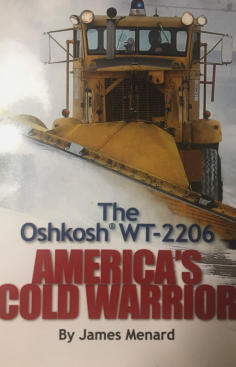
HALL-SCOTT ENGINES
CONTACT SPIKE
817-760-6229
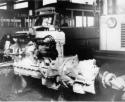
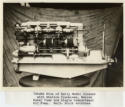


“Attention”
Don’t scrap that engine or parts.
Call us instead, we will help you find a home for them.
